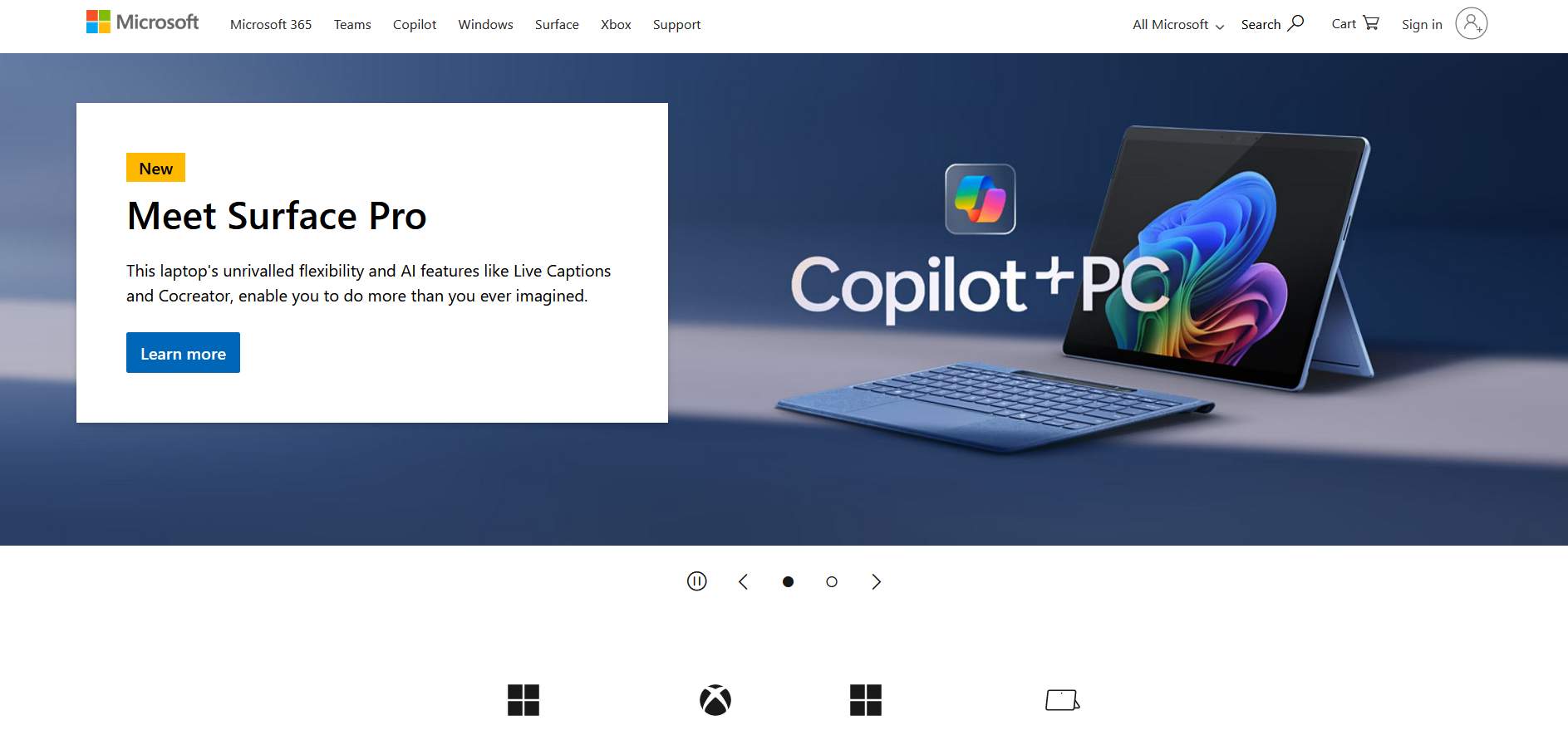The Best Tech Stocks To Buy Right Now



Editorial Note: While we adhere to strict Editorial Integrity, this post may contain references to products from our partners. Here's an explanation for How We Make Money. None of the data and information on this webpage constitutes investment advice according to our Disclaimer.
Best tech stocks to buy now:
- Nvidia - dominates the GPU market, essential for gaming, AI, and data centers
- Microsoft - leads in software, cloud computing, and enterprise solutions
- Google (Alphabet) - dominates online search, digital advertising, and mobile OS markets
- Apple - strong global brand in consumer electronics with integrated product ecosystem
- Meta (Facebook) - owns major social media platforms and invests in virtual reality and the metaverse
- Amazon - leader in e-commerce and cloud services with diverse revenue streams
- Broadcom - major player in semiconductors and infrastructure software with steady growth
Investing in technology stocks has become one of the most popular and profitable types of investments in recent years. In an environment of rapid growth and advancement in technology, choosing the best technology stocks can not only generate significant profits, but also provide sustainable growth to any investor's investment portfolio. Let's look at the key aspects to consider when choosing technology stocks, the best stocks to buy now, and discuss accessible and affordable stocks with high growth potential.
Best tech stocks to buy now
There are several tech stocks that are considered the best in the market right now. These include giants such as Microsoft, Google (Alphabet), Amazon and Nvidia. These companies dominate the market due to their innovation, strong financial performance and leadership positions in their industries.
Nvidia

Nvidia continues to lead in the production of graphics processors, which is especially relevant in the era of growing popularity of video games and artificial intelligence. The company's products are in high demand among gamers and professionals working with artificial intelligence and machine learning.
Main features:
Industry Leadership: Nvidia dominates the GPU market, essential for gaming, AI, and data centers.
Innovation: The company leads in AI and machine learning technologies, crucial for future growth.
Financial Performance: Nvidia shows consistent revenue and profit growth.
Market Trends: Rising demand for high-performance computing and AI supports Nvidia's growth prospects. Explore the AI boom, its impact on industries, and how investors can profit from AI-driven tech stocks. Learn about key companies, market trends, and future advancements.
Microsoft

Microsoft continues to show strong financial performance through its cloud services and software. Azure cloud solutions are one of the company's primary growth engines, providing a significant portion of its revenue. Microsoft's software, including Windows and Office, also remains popular with users around the world.
Main features:
Dominant Position: Microsoft leads in software, cloud computing, and enterprise solutions.
Continuous Innovation: Products like Azure, Office 365, and AI technologies show constant innovation.
Strong Financials: Consistent revenue and profit growth demonstrate robust financial performance.
Growth Opportunities: The shift towards cloud computing and digital transformation supports future growth.
Google (Alphabet)

Google holds a leading position in online advertising and artificial intelligence. The company owns such popular services as YouTube and Google Search, which provide a steady stream of advertising revenue. In addition, Google is actively investing in developments in the field of artificial intelligence, which opens up new prospects for growth.
Main features:
Market Leader: Alphabet dominates online search, digital advertising, and mobile OS markets.
Cutting-Edge Technology: Focus on AI, cloud services, and autonomous vehicles through Waymo.
Revenue Growth: Steady revenue increase driven by advertising and new business ventures.
Future Trends: Increasing digital ad spending and cloud computing growth bolster Alphabet’s prospects.
Apple

Apple Inc. is one of the world's leading technology companies, known for its innovative products such as the iPhone, iPad, MacBook, and Apple Watch. Apple continues to show steady growth thanks to its strong brand, high-quality products, and ongoing innovations in technology and design. Apple's financial metrics remain strong, making its stock attractive to long-term investors.
Main features:
Brand Loyalty: Apple is renowned for its strong brand and global leadership in consumer electronics.
Integrated Ecosystem: Diverse product lineup including iPhones, Macs, iPads, and wearables.
High Margins: Robust revenue and profit growth with high profit margins.
Consumer Demand: Continuous demand for premium electronics and services drives long-term growth.
Meta (Facebook)

Meta Platforms Inc. is a company engaged in social media and virtual reality technologies. Its main products include Facebook, Instagram, WhatsApp, and Oculus. Meta is heavily investing in the development of the metaverse, which opens new growth prospects. Despite challenges related to regulatory issues and competition, Meta maintains a strong market position.
Main features:
Social Media Giant: Meta owns major platforms like Facebook, Instagram, and WhatsApp.
Future Focus: Strong investment in virtual reality and the metaverse with Oculus and Reality Labs.
Ad Revenue: Significant income from digital advertising with a vast user base.
Technological Advances: Growth in digital ad spending and AR/VR advancements favor Meta's expansion.
Amazon

Amazon.com Inc. is the world's largest e-commerce and cloud computing company. In addition to its online store, Amazon operates the popular cloud platform AWS, which is a major source of revenue for the company. Amazon is known for its wide range of products, fast delivery, and innovative technologies, making its stock attractive to investors.
Main features:
E-commerce Powerhouse: Amazon is a leader in online retail and logistics.
Cloud Services: Amazon Web Services (AWS) is a top cloud platform with strong growth potential.
Diverse Revenue Streams: Consistent revenue growth across various business segments.
Market Trends: Increasing e-commerce adoption and reliance on cloud services support Amazon’s growth.
Broadcom

Broadcom Inc. is a global technology company specializing in the production of semiconductors and infrastructure software. Broadcom's products are used in various devices, from smartphones to networking equipment. The company is known for its highly efficient and innovative semiconductor solutions, ensuring its steady growth and attractiveness to investors.
Main features:
Tech Leadership: Broadcom is a major player in semiconductors and infrastructure software.
Advanced Development: Focus on innovative technologies for networking, broadband, and wireless communications.
Steady Growth: Consistent revenue and profit growth supported by strategic acquisitions.
Rising Demand: Growing need for semiconductors and infrastructure software drives Broadcom’s expansion.
To buy best tech stocks, we have selected several brokers. They open the doors to the stock market where you can buy shares of the above mentioned companies and shares of other companies you like. These brokers are reliable and offer good terms on deals.
| Plus500 | Pepperstone | OANDA | FOREX.com | Interactive Brokers | |
|---|---|---|---|---|---|
|
Stocks |
Yes | Yes | Yes | Yes | Yes |
|
Demo |
Yes | Yes | Yes | Yes | Yes |
|
Min. deposit, $ |
100 | No | No | 100 | No |
|
Max. leverage |
1:300 | 1:500 | 1:200 | 1:50 | 1:30 |
|
ECN |
Yes | Yes | Yes | Yes | Yes |
|
ECN Commission, $ per lot |
No | 3 | 3,5 | 5 | 2 |
|
Investor protection |
€20,000 £85,000 SGD 75,000 | £85,000 €20,000 €100,000 (DE) | £85,000 SGD 75,000 $500,000 | £85,000 | $500,000 £85,000 |
|
Open account |
Open an account Your capital is at risk. |
Open an account Your capital is at risk.
|
Open an account Your capital is at risk. |
Study review | Open an account Your capital is at risk. |
How to choose the best tech stocks
The first thing to look at when choosing Best Tech Stocks is the underlying metrics. These metrics include financial metrics such as a company's revenue, earnings per share (EPS), price-to-earnings (P/E) ratio, and growth rate. Analyzing these metrics helps in determining the financial stability and growth potential of the company. It is also important to consider a company's market share and competitive advantage. Companies that lead in innovation and have significant barriers to entry tend to have a higher chance of success in the long term.
Revenue and earnings per share (EPS)
A company's revenue is one of the main indicators of its financial health. A high level of revenue indicates a strong market position and a steady demand for the company's products or services. Earnings per share (EPS) shows how much of the company's profit each shareholder receives, which is an important factor for investors.
Price/Earnings ratio (P/E)
The price/earnings ratio (P/E) shows how much investors are willing to pay for one dollar of a company's earnings. A low P/E may indicate that the stock is undervalued, while a high P/E may indicate that expectations of the company's future growth are inflated. However, it is important to note that P/E ratio is used for relative valuation, i.e. P/E ratios of similar companies are meant to be compared, and the same is not to be seen as an absolute measure on an individual basis.
Market share
A company's market share shows its position in the industry compared to its competitors. Companies with a large market share tend to have stable revenues and can more easily adapt to changes in the market.
Competitive advantages
Competitive advantages, such as unique technologies, patents, and strong brands, help companies maintain leadership positions and provide long-term sustainability. An example of a successful investment in tech stocks is Apple, which continues to show steady growth due to its innovative products and strong brand. Investors who invested in Apple early on have been able to grow their capital significantly.
When is the best time to buy tech stocks?
In addition to the fundamentals, it is important to consider other key factors when picking stocks. The impact of macroeconomic conditions, such as the state of the economy and inflation rates, can have a significant impact on stock prices.
During periods of economic growth, companies tend to perform better, which boosts their stock price. In a recession, stock values can decline as companies face declining demand and revenues. It is this period of the economic cycle that is considered the most attractive time to buy Best Tech Stocks.
High inflation can reduce consumers' purchasing power and increase companies' costs, which negatively affects their financial results. Low inflation, on the other hand, promotes stable growth. Therefore, it is better to buy Best Tech Stocks when inflationary momentum is fading.
Industry news and innovation also play a significant role in the selection of stocks to buy. The emergence of new technologies or products can significantly increase the value of a company's stock. Positive news, such as a successful launch of a new product or a favorable contract, can increase shareholder value. Negative news, such as product problems or financial losses, can cause the stock price to decline. It's also worth keeping an eye on companies' preliminary earnings reports so you can buy shares early. Buying a stock on good news is inefficient, as the stock will have already worked out most of its upside potential.
When investing in shares of technology companies, do not forget about the risks. For example, one of the significant risks of investing in next-generation apps like TikTok (or its parent ByteDance) includes the lack of liquidity associated with private equity investments. Unlike publicly traded shares, pre-IPO shares may be difficult to sell before the IPO occurs. Moreover, private company valuations may not be transparent, adding another layer of uncertainty.
When choosing tech stocks, consider their long-term plans and innovation projects
When selecting technology stocks to buy, I always consider not only the companies' current financial performance, but also their long-term strategic plans and innovation projects. I assess potential risks associated with technological and regulatory changes in the industry. To diversify my investments, I choose stocks of companies from different segments of the technology sector. By following news and trends, I can react to changes in the market in a timely manner. I analyze the competition and growth prospects of the selected companies. Finally, I always remember to review my investment portfolio on a regular basis.
Conclusion
Investing in tech stocks is both exciting and challenging, needing attention and a good strategy. Looking at a company's innovation and market strength can boost the chances of your success while staying updated on market trends and news helps with smart decisions. Diversifying your portfolio reduces risk and creates growth opportunities. Be flexible and ready to change your strategies as the market changes. Successful investing means always learning and adapting to the fast-paced tech world.
FAQs
Why are technology stocks considered promising investments?
Technology stocks are considered promising because of their high growth potential, innovation and constant demand for new technologies and solutions.
How to keep up with news and trends in the technology sector?
Use specialized financial news, analytical reports, newsletters and participate in specialized forums and conferences.
What are the risks associated with investing in technology stocks?
Risks include high volatility, technological changes, competition and regulatory changes that could affect the company's financial results.
How to reduce risks when investing in technology stocks?
Risks are reduced by portfolio diversification. Distributing investments across different segments of the technology sector increases the stability and profitability of the portfolio.
Related Articles
Team that worked on the article
Chinmay Soni is a financial analyst with more than 5 years of experience in working with stocks, Forex, derivatives, and other assets. As a founder of a boutique research firm and an active researcher, he covers various industries and fields, providing insights backed by statistical data. He is also an educator in the field of finance and technology.
As an author for Traders Union, he contributes his deep analytical insights on various topics, taking into account various aspects.

Dr. BJ Johnson is a PhD in English Language and an editor with over 15 years of experience. He earned his degree in English Language in the U.S and the UK. In 2020, Dr. Johnson joined the Traders Union team. Since then, he has created over 100 exclusive articles and edited over 300 articles of other authors.
Mirjan Hipolito is a journalist and news editor at Traders Union. She is an expert crypto writer with five years of experience in the financial markets. Her specialties are daily market news, price predictions, and Initial Coin Offerings (ICO).
Diversification is an investment strategy that involves spreading investments across different asset classes, industries, and geographic regions to reduce overall risk.
Cryptocurrency is a type of digital or virtual currency that relies on cryptography for security. Unlike traditional currencies issued by governments (fiat currencies), cryptocurrencies operate on decentralized networks, typically based on blockchain technology.
Forex leverage is a tool enabling traders to control larger positions with a relatively small amount of capital, amplifying potential profits and losses based on the chosen leverage ratio.
An ECN, or Electronic Communication Network, is a technology that connects traders directly to market participants, facilitating transparent and direct access to financial markets.
Volatility refers to the degree of variation or fluctuation in the price or value of a financial asset, such as stocks, bonds, or cryptocurrencies, over a period of time. Higher volatility indicates that an asset's price is experiencing more significant and rapid price swings, while lower volatility suggests relatively stable and gradual price movements.






























































































































